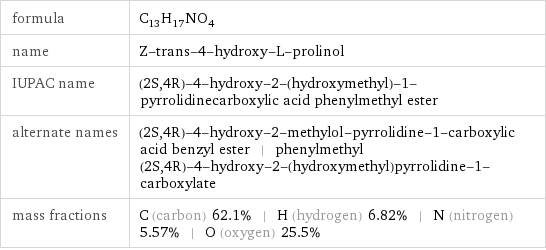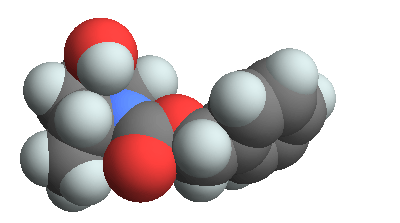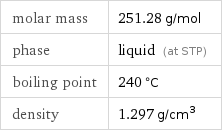Input interpretation

Z-trans-4-hydroxy-L-prolinol
Chemical names and formulas

formula | C_13H_17NO_4 name | Z-trans-4-hydroxy-L-prolinol IUPAC name | (2S, 4R)-4-hydroxy-2-(hydroxymethyl)-1-pyrrolidinecarboxylic acid phenylmethyl ester alternate names | (2S, 4R)-4-hydroxy-2-methylol-pyrrolidine-1-carboxylic acid benzyl ester | phenylmethyl (2S, 4R)-4-hydroxy-2-(hydroxymethyl)pyrrolidine-1-carboxylate mass fractions | C (carbon) 62.1% | H (hydrogen) 6.82% | N (nitrogen) 5.57% | O (oxygen) 25.5%
Lewis structure

Draw the Lewis structure of Z-trans-4-hydroxy-L-prolinol. Start by drawing the overall structure of the molecule, ignoring potential double and triple bonds: Count the total valence electrons of the carbon (n_C, val = 4), hydrogen (n_H, val = 1), nitrogen (n_N, val = 5), and oxygen (n_O, val = 6) atoms: 13 n_C, val + 17 n_H, val + n_N, val + 4 n_O, val = 98 Calculate the number of electrons needed to completely fill the valence shells for carbon (n_C, full = 8), hydrogen (n_H, full = 2), nitrogen (n_N, full = 8), and oxygen (n_O, full = 8): 13 n_C, full + 17 n_H, full + n_N, full + 4 n_O, full = 178 Subtracting these two numbers shows that 178 - 98 = 80 bonding electrons are needed. Each bond has two electrons, so in addition to the 36 bonds already present in the diagram add 4 bonds. To minimize formal charge oxygen wants 2 bonds and carbon wants 4 bonds. Identify the atoms that want additional bonds and the number of electrons remaining on each atom: Fill in the 4 bonds by pairing electrons between adjacent highlighted atoms. Note that the six atom ring is aromatic, so that the single and double bonds may be rearranged: Answer: | |
3D structure

3D structure
Basic properties

molar mass | 251.28 g/mol phase | liquid (at STP) boiling point | 240 °C density | 1.297 g/cm^3
Units

Liquid properties (at STP)

density | 1.297 g/cm^3 refractive index | 1.547
Units

Chemical identifiers

CAS number | 95687-41-5 PubChem CID number | 14994791 PubChem SID number | 24878751 SMILES identifier | C1C(CN(C1CO)C(=O)OCC2=CC=CC=C2)O
Safety properties

flash point | 110 °C